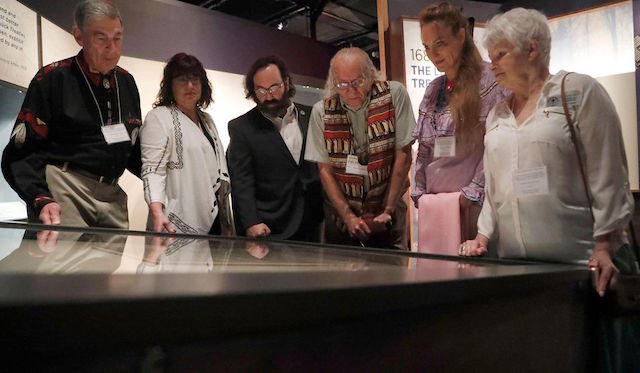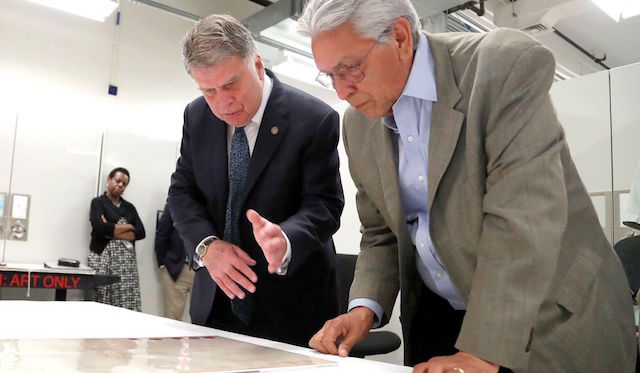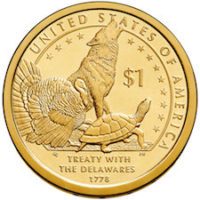The Treaty With the Delawares, signed in 1778, has arrived at the National Museum of the American Indian

Treaty With the Delawares, 1778: Agreements like the Treaty With the Delawares (1778) are powerful reminders of American Indian nations’ legal right to territorial sovereignty. (Paul Morigi)
The narrative of the American Revolutionary War is often presented as a story of tidy alliances: Britons and Germans on one side, Americans and French on the other. But what of those over whose ancestral lands the conflict was waged—Native Americans?
Native peoples had been driven steadily westward in the decades prior to the war, as boatloads upon boatloads of land-hungry colonists pushed heedlessly (and often violently) into their territory. As revolution dawned, however, settlers began to realize that making allies rather than adversaries of Native Americans could prove to be a useful strategy, given the indigenous peoples’ manpower as well as their prodigious knowledge of the battlegrounds.
In 1776, the Declaration of Independence asserted the existence of a coherent United States, a national entity distinct from Britain and entitled to its own system of law. This declaration implied that the 13-state collective was within its rights to negotiate and ratify formal international treaties, just like any other country. Pursuing treaties with indigenous peoples quickly became a high priority for the United States.
The first-ever treaty concluded by the fledgling U.S. and a Native American nation was the Treaty With the Delawares, endorsed by representatives of both factions in 1778. Predictably, the Continentals had reached out to the Delaware people for reasons of military exigency. American forces were looking to stage a strike on the British stronghold of Detroit, which would necessitate travel through Delaware Indian territory. The Patriots’ hope was that the Delawares could be coaxed out of neutrality with a favorable treaty.
Following negotiations between Continental ambassadors and the moderate Delaware leader White Eyes, a treaty was signed on both sides. That groundbreaking document, on loan from the National Archives in the latest in a series of short-term treaty loans, joined the National Museum of the American Indian’s “Nation to Nation” exhibition earlier this month.
As museum director Kevin Gover stated during the unveiling ceremony, “Nation to Nation” gets at “the core relationship between the Indian nations and the United States” through a selection of treaties enacted across American history. The Treaty With the Delawares, which will provide visitors to the exhibition with a powerful historical embarkation point, will be on view through September of 2018.

Members of the Delaware Tribe of Indians view the Treaty With the Delawares at the May 10 unveiling of the document at the National Museum of the American Indian in Washington, D.C. (Paul Morigi)
Mark Hirsch, a historian at the museum, notes that the Delaware Treaty was much more conciliatory on the part of the U.S. than many of us today might expect. “In order to get the Delaware to pledge their peace and friendship to the United States, the United States felt that it really had to show some serious allegiance to the Delaware,” he says. “So they put in a very interesting clause, which offered the Delaware the opportunity to become, with other pro-United States Indian tribes, a 14th state in the Union.”
Unfortunately, that offer never got off the ground. Following the ratification of the treaty (which was very informal by today’s standards—Hirsch explains that Congressional approval was not yet a hard and fast requirement, and was not technically obtained), relations between the Delaware and the U.S. soured, with both sides questioning the legitimacy and implications of the document.
“The Delaware really did honor their side of the bargain,” Hirsch says—they guided Continental troops through their territory and on to the British in what is now Michigan. Many Delawares feared their leaders had been conned—lured into a full-on military alliance with the Patriots when all they had wanted was to stay out of the conflict. “It seems that some of the Delaware looked back on this treaty and said, ‘The chiefs didn’t understand what they were signing,’” Hirsch explains, “and that they were told things that were falsely translated by interpreters, and that they had no intention to join a military alliance with the United States.”
These grievances began to bubble to the fore in earnest following the presumed murder of White Eyes, the Delawares’ open-minded leader, at the hands of none other than the Continental Army, mere months after the treaty he signed took effect. “He was assassinated while leading colonials to Detroit,” current-day Delaware chief Chet Brooks lamented at the recent unveiling ceremony. “They sent word back to our people that White Eyes had died of smallpox, but our people knew that that couldn’t be, because White Eyes had had smallpox earlier and survived it. You don’t get it twice.”
Who exactly killed White Eyes and why are questions with no clear answers, but it’s undisputed that the sudden betrayal hit the Delaware people hard. White Eyes was a compromiser, Hirsch explains, more accommodating to white settlers than virtually any other Delaware Indian. “He’s looking for a way to both safeguard tribal sovereignty and figure out a way of living with American settlers and have his people survive,” Hirsch explains. “And he’s assassinated.” Understandably, Hirsch says the murder of such a temperate, approachable man made the rest of the Delawares fearful for their own lives.
This heinous incident, coupled with wide-ranging failures on the part of the U.S. to live up to its bargains with other Indian nations, thoroughly disillusioned the Delaware people, driving them to swing their allegiance the other way, in the direction of the British. “They were very angry,” Hirsch says, “and really felt like the United States had only one interest: to dispossess them of their tribal territories.” From 1779 through to the end of the war, the Delawares were in the Redcoat camp.

Archivist of the United States David Ferriero and American Indian Museum director Kevin Gover examine the latest addition to “Nation to Nation” prior to its installation. (Paul Morigi)
Hirsch and Gover are grateful for the National Archives’ ongoing work to bring this rich, oft-forgotten American history to the American Indian Museum’s public audience. Hirsch says that the “Nation to Nation” exhibition provides an essential and vivid reminder that Indian nations are sovereign entities with unalienable rights all their own, and are deserving of international recognition and respect.
“The fact that you have treaties between the United States and tribes means that those tribes are actually viewed as nations that are sovereign, like any foreign nation,” Hirsch says. “We felt that a lot of our visitors, most of our visitors in fact, did not know that.” “Nation to Nation,” he says, is the perfect way of hammering that point home.
“When we first began working together on the ‘Nation to Nation’ exhibition” in 2014, Archivist of the United States David Ferriero told the crowd of guests assembled for the unveiling, “the plan was a four-year run with eight treaties. It’s been such a success that we’re working together to extend the exhibition and treaty loans until 2021.” He is optimistic the show will continue even beyond then.
To this day, 18th and 19th-century treaties are invoked in courts of law in cases pertaining to the enduring question of Native American land rights. Hirsch’s ultimate hope is that visitors to “Nation to Nation” will come away with a grasp of how treaties have shaped this country and its relation to native peoples, and how those treaties continue to influence us even now.
“We want people to understand that these treaties aren’t just old pieces of paper with no contemporary relevance,” Hirsch says. “Treaties, according to the Constitution, are the highest law of the land. And many are still in effect.”
While acknowledging the historically abysmal track record of the United States when it comes to honoring its treaties with Indian peoples, Hirsch says that it’s not too late to turn the trend around and use the treaties on the books for good. “They’re in effect, they’re still the law of the land, and they recognize tribes as nations,” he says. “And I think having the actual treaties in the gallery makes that point very forcefully.”
Researched and written by Ryan P. Smith and published by The Smithsonian ~ May 24, 2018.

2013 Native American One Dollar Uncirculated Reverse
FAIR USE NOTICE: This site contains copyrighted material the use of which has not always been specifically authorized by the copyright owner. We are making such material available in our efforts to advance understanding of environmental, political, human rights, economic, democracy, scientific, and social justice issues, etc. We believe this constitutes a ‘fair use’ of any such copyrighted material as provided for in section 107 of the US Copyright Law. In accordance with Title 17 U. S. C. Section 107, the material on this site is distributed without profit to those who have expressed a prior interest in receiving the included information for research and educational purposes. For more information go to: http://www.law.cornell.edu/uscode/17/107.shtml
